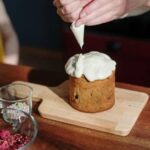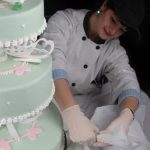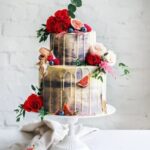If you have ever marveled at the impeccably decorated cakes on display, you may have wondered how those intricate sugar decorations were made. In this article, we will delve into the world of sugar decorations for cakes and uncover the secrets behind creating stunning edible designs that will elevate your cakes to a whole new level.
Sugar decorations have long been an essential part of cake decorating, adding flair and visual appeal to even the simplest of creations. What makes them truly magical is their versatility – they can be molded and shaped into almost any design imaginable. From delicate flowers to whimsical figures, sugar decorations allow decorators to let their creativity run wild, bringing stunning works of edible art to life.
While it may be tempting to purchase pre-made sugar decorations, making your own offers a host of benefits. Firstly, it is a cost-effective option that saves you money in the long run.
Additionally, crafting your own decorations allows for complete customization, ensuring that every element on your cake perfectly fits your vision and theme. So grab some powdered sugar and corn syrup – let’s dive in and uncover all there is to know about creating beautiful sugar decorations for cakes.
Why Make Your Own Sugar Decorations?
Making your own sugar decorations for cakes can elevate your baking and cake decorating skills to a whole new level. While store-bought decorations are readily available, creating your own sugar decorations offers a unique touch of artistry and personalization to your cakes. Here are some compelling reasons why you should consider making your own sugar decorations:
- Cost-effectiveness: Making your own sugar decorations can save you money in the long run. Store-bought decorations can be quite expensive, especially when you need a variety of shapes and designs. By learning how to make your own, you can have an endless supply of creative options at a fraction of the cost.
- Customization: When you make your own sugar decorations, you have complete control over the design, colors, and size. You can tailor the decorations to match specific themes or occasions, ensuring that each cake is a one-of-a-kind masterpiece. Whether you want delicate flowers or whimsical figures, making your own allows you to bring your vision to life.
- Creative expression: Making sugar decorations allows you to unleash your creativity and explore different artistic techniques. It’s an opportunity to experiment with various shapes, colors, and textures, creating unique edible works of art that reflect your personal style. The possibilities are endless when it comes to designing beautiful cake embellishments.
To get started on making your own sugar decorations, let’s take a look at the essential tools and ingredients needed for this sweet endeavor.
Essential Tools and Ingredients for Sugar Decorations
To create beautiful and intricate sugar decorations for cakes, there are a few essential tools and ingredients that you’ll need in your arsenal. These tools will help you mold, shape, and color the sugar to bring your designs to life. Additionally, specific ingredients will ensure that the decorations are not only visually appealing but also tasty.
When it comes to tools, here are some essentials that every aspiring sugar decorator should have:
- Silicone molds: These are great for creating consistent shapes and figures. Look for molds in various sizes and designs to add versatility to your creations.
- Piping bags and tips: Piping bags allow for precise control when adding details or writing on cakes. Different tips can be used to achieve different effects, such as creating fine lines or adding texture.
- Modeling tools: These tools help with shaping the sugar decorations, smoothing edges, and adding detail. Look for a set that includes various shapes and sizes.
- Airbrush gun: While not essential, an airbrush gun can elevate your sugar decorations by allowing you to easily add color gradients or intricate patterns.
Now let’s talk about the key ingredients you’ll need:
- Powdered sugar (also known as confectioners’ sugar): This is the main ingredient used to make sugar paste or fondant. It provides sweetness while also giving the paste its malleable texture.
- Corn syrup: Corn syrup is added to the powdered sugar to create an elastic and pliable consistency. It helps prevent cracking and tearing when working with the sugar paste.
- Food coloring: Gel or powdered food coloring works best for achieving vibrant colors without altering the consistency of the sugar paste too much.
| Tools | Ingredients |
|---|---|
| Silicone molds | Powdered sugar (confectioners’ sugar) |
| Piping bags and tips | Corn syrup |
| Modeling tools | Food coloring (gel or powdered) |
Having these essential tools and ingredients at your disposal will set you up for success in creating beautiful sugar decorations for cakes. In the next section, we will delve into a step-by-step guide on how to create basic sugar shapes and figures, so stay tuned.
Step-by-Step Guide
Creating basic sugar shapes and figures is a great starting point for beginners in the world of sugar decorations for cakes. These simple designs can add a touch of elegance and creativity to any cake, and the best part is that they are easy to make. In this section, we will provide you with a step-by-step guide on how to create basic sugar shapes and figures.
To begin, you will need a few essential tools such as silicone molds, rolling pin, cookie cutters (in various shapes and sizes), and an offset spatula. These tools will help you shape and mold the sugar into different forms. Additionally, you will need powdered sugar, corn syrup, food coloring (gel or powder form), and a small brush for adding color details.
First, start by preparing your sugar mixture. In a mixing bowl, combine powdered sugar with a small amount of corn syrup until it forms a thick paste-like consistency. This mixture will serve as the base for your sugar decorations.
Next, take a small portion of the mixture and knead it with clean hands until it becomes pliable. If the mixture is too sticky, dust your hands with powdered sugar before kneading it further.
Once your mixture is ready, roll it out evenly using a rolling pin on a clean surface lightly dusted with powdered sugar. This will ensure that the sugar does not stick to the surface. You can adjust the thickness of your rolled-out piece depending on how sturdy or delicate you want your decoration to be.
Now comes the fun part – shaping. Use cookie cutters or free-hand techniques to cut out different shapes from the rolled-out sugar sheet. With an offset spatula or toothpick, you can also add texture or fine details like eyes or mouths to your figures.
For coloring your creations, mix tiny amounts of food coloring gel or powder with water in separate bowls. Use a small brush to paint each shape or figure with vibrant colors according to your preference. Allow the decorations to dry completely before handling or placing them on your cake.
Creating basic sugar shapes and figures allows you to unleash your creativity and add a personal touch to your cakes. With practice, you can experiment with various shapes, sizes, and colors to match any theme or occasion. So go ahead and give it a try – the possibilities are endless.
Advanced Techniques
Creating intricate sugar designs and patterns can take your cake decorations to the next level, adding a touch of elegance and sophistication. These advanced techniques allow you to create mesmerizing details that will leave your guests in awe. In this section, we will explore some of the techniques used to achieve detailed sugar decorations.
Using Molds:
One way to create intricate sugar designs is by utilizing molds. These can be found in a variety of shapes and sizes, allowing you to create delicate patterns and textures with ease. Simply press your sugary mixture into the mold, ensuring it fills all the crevices, then carefully remove it to reveal your beautifully designed decoration.
Piping:
Another technique for creating intricate sugar designs is piping. This involves using royal icing or a similar icing consistency to pipe intricate designs onto parchment paper or acetate sheets. Once dried, these piped decorations can be carefully lifted off and placed onto your cake for a stunning effect.
Airbrushing:
For those looking for a more unique and artistic approach, airbrushing can be employed to create stunning gradients, shading, and unique effects on your sugar decorations. With an airbrush tool and food-grade airbrush colors, you can spray a fine mist of color onto your creations, adding depth and dimension.
While creating intricate sugar designs requires practice and patience, the results are well worth it. The key is to start with simple patterns and gradually work your way up as you become more comfortable with the techniques. Don’t be afraid to experiment with different tools and ingredients until you find what works best for you.
Remember that creativity plays a crucial role in this process – let inspiration guide you as you explore the endless possibilities that intricate sugar designs have to offer. Mastering these advanced techniques will not only impress your friends and family but also unleash your inner artist in the world of cake decorating.
Decorating with Sugar Flowers and Leaves
The art of creating sugar flowers and leaves is a popular and beautiful way to enhance the aesthetics of any cake. Edible sugar flowers and leaves not only add a touch of elegance but also allow for endless creativity in cake decoration. Whether you are a beginner or an experienced baker, learning how to make these delicate decorations can take your cake decorating skills to the next level.
To create realistic and stunning floral decorations, you will need a few essential tools and ingredients. Here is a list of what you will need:
- Flower cutters: These come in various shapes and sizes and are used to cut out the petals or leaves of the flowers.
- Veining tools: These tools help create texture and vein patterns on the petals and leaves, giving them a lifelike appearance.
- Foam pad: This is used as a work surface when thinning out the edges of the petals or leaves, creating a more natural look.
- Rolling pin: You will need this tool to roll out your sugar paste or gum paste to the desired thickness.
- Edible glue: This adhesive is used to attach different parts of the flower together and secure it onto the cake.
When it comes to ingredients, powdered sugar, corn syrup, gum paste (or fondant mixed with tylose powder), and food coloring are essential for making sugar flowers and leaves. With these basic supplies, you can start experimenting with different flower types such as roses, daisies, peonies, orchids, and more.
Creating sugar flowers and leaves involves several steps that require patience and attention to detail. Here is a step-by-step guide to get you started:
- Roll out your gum paste or fondant thinly using a rolling pin.
- Use flower cutters dipped in cornstarch or powdered sugar to cut out petals or leaf shapes.
- Place each petal or leaf on a foam pad and use a veining tool to create realistic texture.
- Thin the edges of the petals or leaves by gently tapping them on the foam pad with a ball tool.
- Allow the petals or leaves to dry for a few hours or overnight until they are firm and hold their shape.
- Assemble the flower by using edible glue to attach the petals together, starting from the center and working your way outwards.
- Attach completed flowers and leaves onto your cake using edible glue.
By following these steps and experimenting with different techniques, you can create an array of stunning sugar flowers and leaves to decorate your cakes. From simple blossoms to intricate arrangements, these handmade decorations will surely impress anyone who sees them.
Remember that practice makes perfect, so don’t be discouraged if your first attempts are not as beautiful as you imagined. Keep practicing, learn from your mistakes, and soon enough, you will be able to create breathtaking sugar flowers and leaves that will make every cake a masterpiece.
Adding a Touch of Elegance
What is Royal Icing?
Royal icing is a versatile and popular medium used in cake decorating to create intricate details and embellishments. It is made from a combination of egg whites or meringue powder, confectioners’ sugar, and water. The resulting icing has a smooth consistency that makes it perfect for piping delicate designs onto cakes, cookies, and other baked goods. Royal icing dries hard, creating a beautiful finish that can be painted or dusted with edible powders for added depth and dimension.
Making Royal Icing
To make royal icing, you will need the following ingredients: 2 pounds of confectioners’ sugar, 5 tablespoons of meringue powder, and about 1/2 cup of warm water. In a large bowl, whisk together the confectioners’ sugar and meringue powder until well combined. Gradually add warm water while stirring continuously until the mixture reaches a thick but pipeable consistency. You can adjust the consistency by adding more water if needed.
Using Royal Icing for Intricate Details
Royal icing can be used to create a wide variety of intricate details on your cake decorations. It can be piped into borders, filigree designs, lace patterns, and even three-dimensional figures like flowers or figurines. To work with royal icing, transfer it to a piping bag fitted with a small round tip or any desired piping tips depending on the design you want to achieve.
When piping with royal icing, it’s important to keep the pressure on the piping bag consistent to maintain an even flow of icing. Practice on parchment paper or wax paper first before piping onto your cake. You can use toothpicks or skewers to help guide your lines or create finer details.
Remember that royal icing dries quickly once exposed to air, so it’s important to work efficiently. If the icing starts to stiffen in the piping bag, simply give it a gentle squeeze to soften it up again. To add color to your royal icing, use gel or powdered food coloring, as liquid food coloring can alter the consistency of the icing.
With practice and patience, you can create stunning and elegant designs using royal icing. Experiment with different techniques such as flooding, brushing, stenciling, and adding sugar pearls or dragees for additional texture and flair. The possibilities are endless when it comes to incorporating royal icing into your cake decorations.
Troubleshooting Tips and Common Mistakes to Avoid
While making sugar decorations for cakes can be a fun and rewarding experience, it is not without its challenges. However, with the right knowledge and preparation, you can avoid common mistakes and troubleshoot any issues that may arise along the way. In this section, we will address some common problems that beginners might encounter and offer tips on how to overcome them.
One common issue that beginners face is humidity affecting their sugar decorations. High humidity can cause sugar decorations to become sticky or droopy, ruining all your hard work. To prevent this, it is essential to work in a cool and dry environment. Consider using a dehumidifier or air conditioner in your workspace to create an ideal crafting atmosphere.
Another mistake that often occurs when making sugar decorations is improper handling, resulting in breakage or deformation of the delicate pieces. To avoid this, be gentle when working with sugar decorations, especially when they are still drying or setting. Use small tools like tweezers or toothpicks to handle tiny details delicately without applying excessive force.
Coloring can also pose challenges when it comes to sugar decorations. If you find that your colors are fading or bleeding during the drying process, try using gel food coloring instead of liquid food coloring. Gel colors are more concentrated and tend to hold their vibrant hues better. Additionally, make sure your decoration is thoroughly dry before adding another color on top of it to prevent smudging or blending.
Lastly, a common mistake beginners make is rushing the drying process. Sugar decorations need sufficient time to dry and set properly; otherwise, they may not hold their shape or become too fragile. Be patient and allow enough time for each layer of your decoration to dry completely before adding additional layers or moving on to the next step.
By being aware of these troubleshooting tips and avoiding these common mistakes, you can achieve professional-looking sugar decorations for your cakes every time. Remember, practice makes perfect, so don’t be discouraged if you encounter some challenges along the way. Enjoy the process, learn from your mistakes, and soon you’ll be creating beautiful and impressive sugar decorations to adorn your cakes.
Showcasing Your Creations
Once you have spent time and effort creating beautiful sugar decorations for your cakes, it’s important to know how to effectively display and store them. Properly showcasing your creations will not only enhance the overall presentation of your cakes but also ensure that your sugar decorations remain in pristine condition until they are ready to be used. In this section, we will explore some tips and techniques for displaying and storing your handmade sugar decorations.
When it comes to displaying your sugar decorations, creativity is key. Consider the theme of your cake and the style of the decoration when deciding on the best way to showcase it. Some popular options for display include cake stands, dessert trays, or even elegant glass domes. By selecting a display method that complements both the decoration and the overall design of the cake, you can create a visually stunning centerpiece that will impress your guests.
In terms of storage, it is essential to protect your delicate sugar decorations from moisture and humidity. One effective way to preserve their freshness is by storing them in an airtight container or a zip-top bag with silica gel packets to absorb any excess moisture. Be sure to place each decoration in separate compartments or wrap them individually in tissue paper or parchment paper to prevent any breakage during storage.
Remember that sugar decorations are sensitive to temperature changes as well. Avoid storing them in areas of extreme heat or cold as this can cause them to melt or become brittle. Instead, opt for a cool and dry place away from direct sunlight.
By following these display and storage techniques, you can make sure that your beautiful sugar decorations maintain their quality and enhance the visual appeal of your cakes. Remember that practice makes perfect, so don’t hesitate to experiment with different methods until you find what works best for you. With proper care and attention, you can truly showcase the artistic beauty of your homemade sugar decorations.
Conclusion
In conclusion, homemade sugar decorations offer a world of creativity and customization for cake decorators. By making your own sugar decorations, you have the ability to personalize your cakes and add a unique touch that cannot be replicated with store-bought options. Not only is it a cost-effective alternative, but it also allows you to create designs that perfectly match the theme or occasion of your cake.
Throughout this article, we have provided a step-by-step guide on creating basic sugar shapes and figures, as well as more advanced techniques for intricate designs. We have explored the art of making edible flowers and leaves with sugar, and introduced the versatility of royal icing for adding elegant details. In addition, we have addressed common mistakes and offered troubleshooting tips to help beginners along their sugar decorating journey.
Now that you have all the essential tools, ingredients, and knowledge at hand, it’s time to unleash your creativity. Don’t be afraid to experiment and push the boundaries of traditional cake decoration. Let your artistic side shine through by using your own handmade sugar decorations. Whether it’s a birthday cake or a wedding masterpiece, your creations will undoubtedly stand out and leave a lasting impression.
So go ahead, dive into the world of homemade sugar decorations for cakes. With practice and patience, you will soon discover the joy of bringing beautiful sugary creations to life. Let each cake become a canvas for your imagination and enjoy the admiration from everyone who indulges in your delicious works of art.
Frequently Asked Questions
How do you make melted sugar decorations?
To make melted sugar decorations, start by preparing a clean, heat-resistant surface. Place a nonstick silicone mat or parchment paper on the surface to prevent sticking. Next, melt granulated sugar in a saucepan over low heat until it fully dissolves and turns into a thick liquid. Be cautious when working with melted sugar as it is extremely hot and can cause severe burns.
Once fully melted, quickly transfer the hot liquid sugar onto the prepared surface. You can shape it into various forms using metal tools or molds before it cools and hardens. Allow the decorations to cool completely before carefully removing them from the silicone mat or parchment paper. These delicate and transparent decorations can add an elegant touch to cakes, pastries, or desserts.
How to make edible decorations for cake?
Creating edible decorations for cakes involves utilizing various techniques and ingredients that are safe for consumption. One versatile option is fondant, a pliable icing made from powdered sugar, water, gelatin or agar-agar powder, glucose syrup, and flavorings for taste enhancements. Roll out the fondant on a smooth surface dusted with powdered sugar to prevent sticking.
Use cookie cutters or specialized shaping tools to create desired shapes such as flowers, stars, hearts, or letters. Additionally, you can color the fondant with food-safe coloring gels prior to rolling it out for more vibrant designs. Once shaped and colored, carefully place the fondant decorations on top of your cake for a personalized touch.
How to make candy decorations for cake?
Making candy decorations for cakes adds a playful and colorful element to desserts. Begin by selecting your preferred type of candy – this could include jelly beans, M&M’s®, gummy bears, licorice ropes, or other small sweets that suit your design vision. Arrange them on top of your frosted cake in creative patterns or as part of themed designs such as flowers, animals, shapes – let your imagination soar!
You can also create unique patterns by crushing candies and sprinkling them on the cake. Ensure that the candy decorations are pressed firmly enough into the frosting to adhere securely. Additionally, it’s worth noting that if you plan to combine candy with chocolate or other perishable elements, it’s best to add them shortly before serving to maintain freshness and prevent any potential color bleeding or texture changes.

Welcome to my blog about home and family. This blog is a place where I will share my thoughts, ideas, and experiences related to these important topics. I am a stay-at-home mom with two young children. I hope you enjoy reading it! and may find some helpful tips and ideas that will make your home and family life even better!





